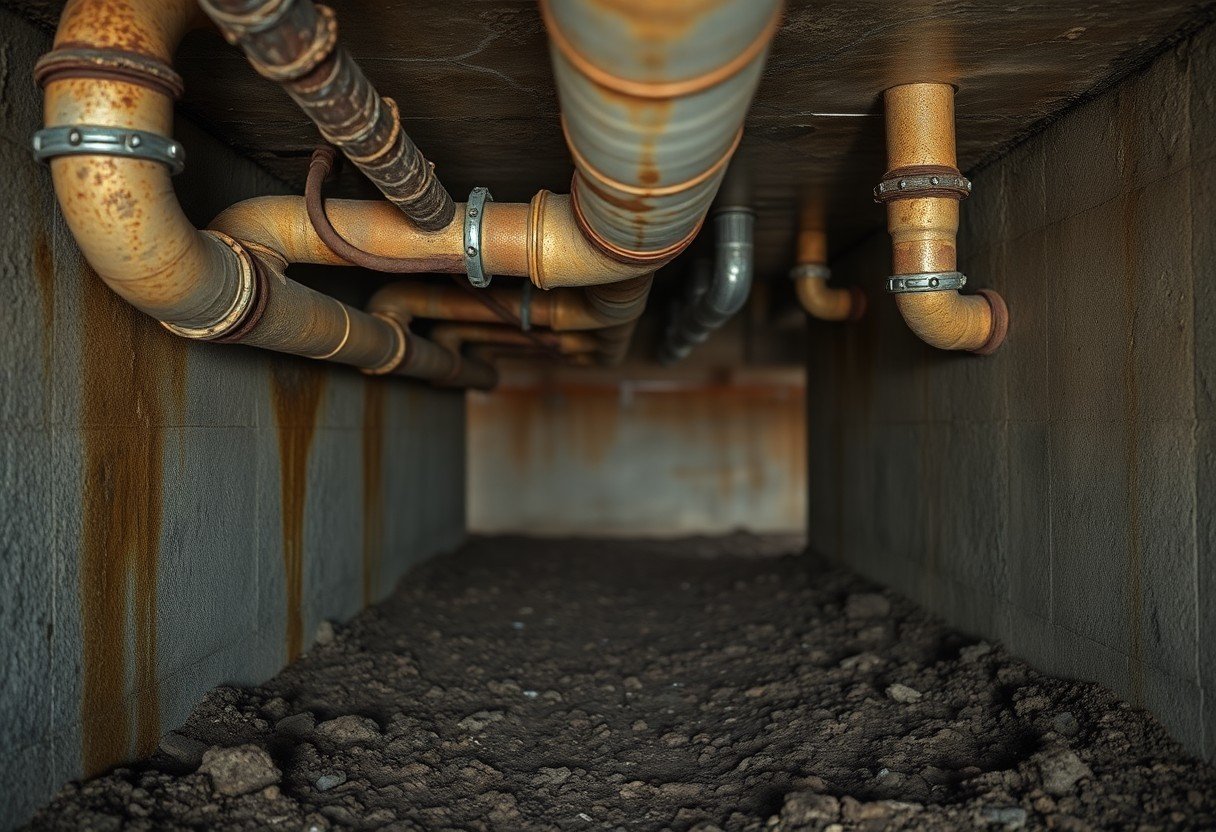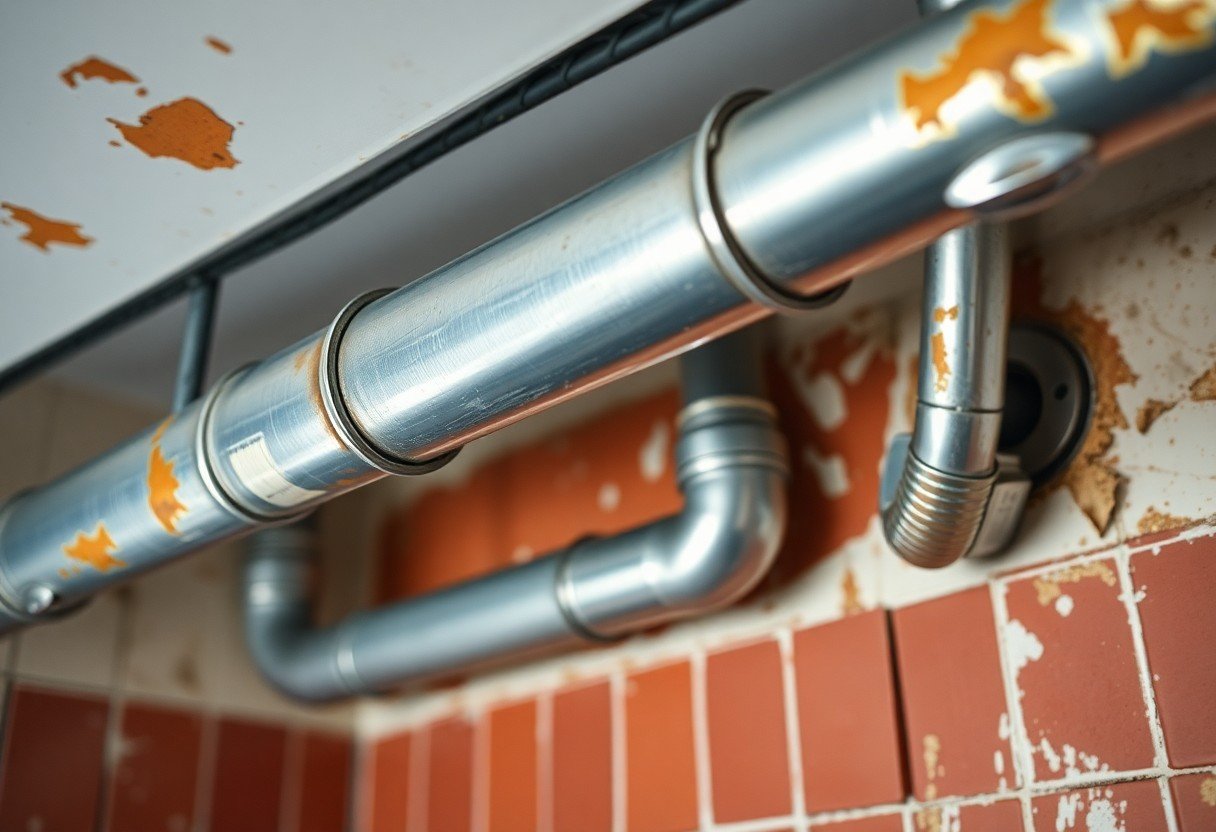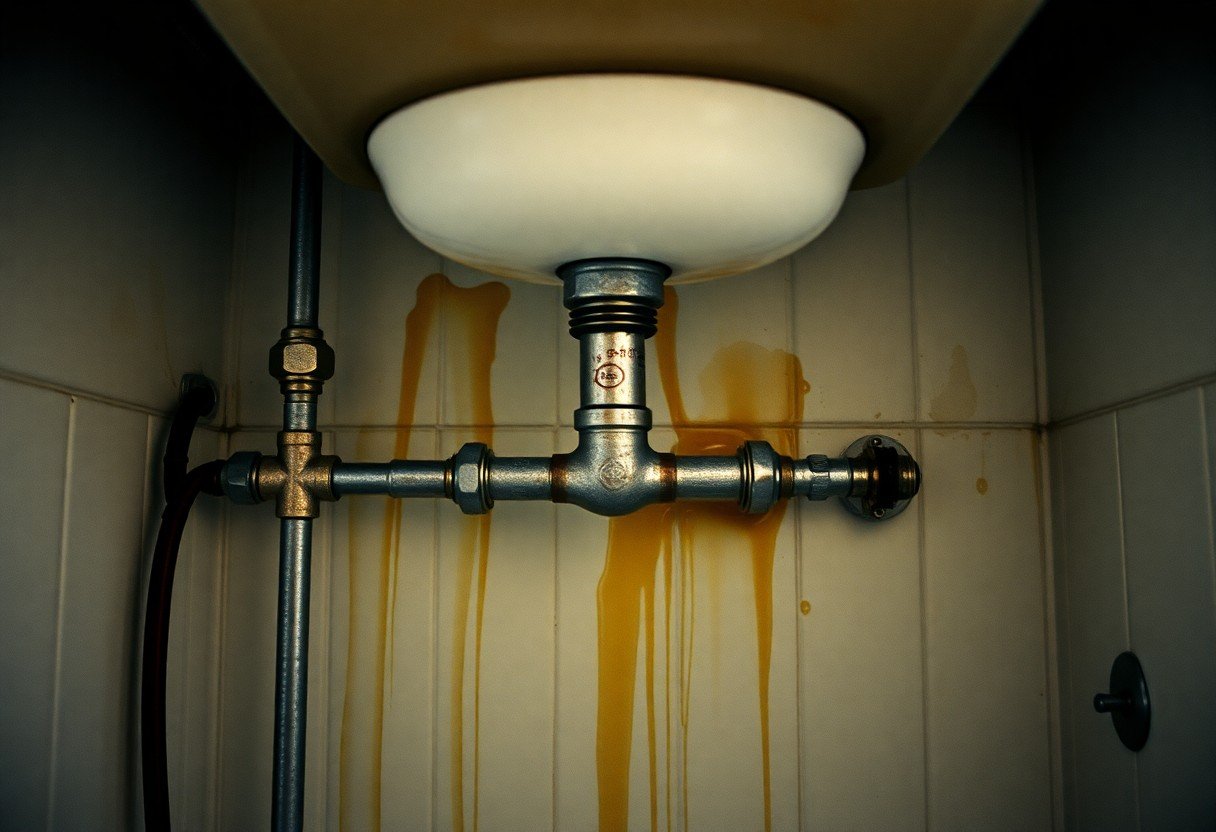Is Galvanized Piping a Problem in Fullerton, California Homes?

Most homeowners in Fullerton, California, may not realize that galvanized piping could pose significant issues for your plumbing system. These pipes, often used in older homes, can lead to corrosion, reduced water flow, and even health risks due to rust contamination. Understanding the state of your plumbing is imperative to ensure the longevity of your home and the safety of your family. In this post, we’ll explore the potential problems associated with galvanized piping and what you can do to address them.
Key Takeaways:
- Galvanized piping in older Fullerton homes can lead to rust and corrosion over time, resulting in potential water quality issues.
- Homeowners should consider inspecting and evaluating existing galvanized pipes, as they may need replacing with more modern materials like copper or PVC.
- Local plumbing codes and guidelines should be checked to ensure compliance and safety when dealing with existing galvanized piping systems.

The Legacy of Galvanized Piping in California Homes
Historical Context of Galvanized Piping
Galvanized piping emerged as a popular plumbing choice in the early 20th century, touted for its resistance to rust and durability. This coating of zinc on steel pipes seemed to provide a reliable solution for water distribution systems during a time when other materials lacked the necessary resilience. Many homes built during this period in Fullerton and throughout California adopted galvanized piping as a standard installation, leading to its widespread use in residential and commercial construction.
Common Applications and Previous Popularity
Originally, galvanized piping was favored for various applications, including water supply lines and outdoor plumbing. Home builders appreciated its strength and longevity, believing it would withstand California’s varied climate. By the 1970s, over 80% of new homes featured galvanized piping, but many now face the repercussions of this once-trusted material.
As your home aged, galvanized pipes began to show signs of wear. With an estimated lifespan of around 20-50 years, many older systems now struggle with corrosion that can impact water quality. The escalating demand for more durable alternatives, such as PEX and copper, has since diminished the popularity of galvanized piping, leading homeowners to seek replacements to ensure reliable plumbing throughout their homes.
Identifying the Signs: When Galvanized Piping Becomes Problematic
As galvanized piping ages, various signs may indicate underlying problems that require your attention. It’s vital to be observant of subtle changes in water flow, pressure, and quality, as these factors can impact both your home’s plumbing system and overall health. Delaying action when you notice these issues can lead to more significant problems and greater repair costs.
Indicators of Corrosion and Deterioration
Common indicators of corrosion include discolored water that may appear reddish or brown, a decrease in water pressure, or rust stains around faucets and fixtures. You might also notice frequent leaks or pipe bursts as the integrity of the pipes weakens over time. If you experience any of these signs, it’s advisable to act quickly and consult a professional.
Water Quality Issues Linked to Galvanized Pipes
Water quality can deteriorate significantly with galvanized pipes, primarily due to the build-up of rust and sediment. This results in tastes, odors, and even health risks, as contaminants can enter your water supply. Monitoring these quality issues should be a priority for homeowners, especially if your home has aging plumbing.
For instance, the presence of lead, which may leach into water from corroding pipes, can pose serious health risks, particularly for children. A noticeable metallic taste or an unpleasant odor in your drinking water often signals a problem. Testing your water regularly can provide insight into these quality issues, helping you stay informed about potential hazards to your family’s health.

The Compliance Conundrum: Building Codes and Regulations
Building codes and regulations in California constantly evolve to ensure the safety and well-being of residents while addressing changes in plumbing materials. Homes built before the 1970s, often having galvanized piping, may not satisfy current standards. Homeowners frequently find themselves navigating this compliance maze, which can influence their decision-making regarding plumbing upgrades or replacements. When faced with issues like leaks or water quality concerns, it can be helpful to consult an expert. For guidance, check out What to Do When You Have a Slab Leak in Your Fullerton Home.
Current California Standards for Plumbing Materials
California’s plumbing code has transitioned away from galvanized piping, endorsing materials with greater durability and efficiency, such as PEX and copper. These materials resist corrosion, ensuring clean water flows and reducing the risk of leaks. While galvanized pipes may have met past standards, they expose you and your home to potential hazards that newer materials effectively mitigate.
Impact of Non-compliance on Homeowners
Failure to adhere to updated plumbing standards can result in significant consequences for homeowners. Non-compliance may lead to property damage, reduced home value, and increased insurance liabilities. Furthermore, local authorities may impose penalties or fines for using outdated plumbing materials, adding financial strain.
When your home does not meet building codes, you risk facing costly repairs and decreased property value. Problems can also extend to insurance coverage, where claims related to plumbing issues may be denied, leaving you financially vulnerable. Addressing non-compliance proactively helps you avoid headaches, maintain home safety, and ensure that your property aligns with legal requirements, ultimately enhancing your home’s overall marketability.
Mitigation Strategies: What Homeowners Can Do
Taking proactive measures can significantly improve your plumbing situation and prevent further complications from galvanized piping. Regular maintenance and inspections will help you stay ahead of potential issues, ensuring your home’s water quality and plumbing systems remain in good working order. If you’re concerned about the condition of your galvanized pipes, there are a few steps you can take to address the situation effectively.
Assessing the Condition of Your Plumbing
Start by conducting a thorough assessment of your plumbing system. Look for signs of rust, leaks, or low water pressure, which may indicate corrosion in the pipes. A professional plumber can help you evaluate the extent of the deterioration and determine whether your galvanized piping needs immediate attention or if minor repairs will suffice.
Options for Replacement or Repair
When considering dealing with galvanized piping, you generally have two main choices: repair or replace. If the damage is limited to specific areas, targeted repairs may solve the issue without the need for a complete overhaul. However, if corrosion is widespread, full replacement with modern materials like PVC or copper may be the better long-term investment.
Choosing replacement often proves beneficial in the long run, especially when considering the lifespan of modern piping materials. PVC and copper options can last significantly longer and eliminate issues related to rust and corrosion. For instance, switching to copper can improve water quality and reduce maintenance costs. While repairs are sometimes feasible, they may only provide a temporary fix, leaving you with the risk of recurring issues down the line. Investing in a full pipe replacement eliminates this risk and enhances your home’s overall plumbing efficiency.
Long-term Implications of Living with Galvanized Pipes
Continuing to use galvanized pipes can lead to serious long-term issues. Over time, these pipes may experience corrosion and build-up, resulting in reduced water flow and potential leaks. Additionally, with the deteriorating state of the pipes, the risk of contamination increases, as rust and sediment can infiltrate your drinking water supply. When considering the overall health of your home’s plumbing, taking action sooner rather than later is vital. For more insights on what to look for when maintaining your plumbing, check out Plumbing Red Flags to Watch for When Buying a Home ….
Financial Considerations in Upgrading
Upgrading from galvanized pipes to modern alternatives can be a significant investment, but the costs can pale in comparison to the long-term savings. Deteriorating pipes may lead to increased water bills, frequent repairs, and, ultimately, full system replacements if left unchecked. When evaluating your financial strategy, consider that the upfront costs of replacement often save you money in the long run through reduced maintenance and lower utility bills.
Health Risks Associated with Delayed Action
Delaying action on old galvanized pipes can expose you and your family to health risks. Corroded pipes can leach harmful substances into your drinking water, including lead and copper. These toxins may lead to serious health issues over time, particularly for young children and pregnant women. Regular tests on your water quality become necessary if you continue to live with aging plumbing.
Additionally, lead exposure has been linked to developmental delays in children, and copper ingestion can cause gastrointestinal distress. With the right interventions, you can avoid these health hazards; however, if galvanized pipes remain in service long after their lifespan, the cumulative effects can be detrimental. Understanding the necessity of timely upgrades not only preserves the integrity of your plumbing but also enhances the health and safety of your household. Taking decisive action today can mitigate risks and safeguard your family’s well-being.
Conclusion
Now that you understand the potential issues associated with galvanized piping in your Fullerton home, it’s important to stay vigilant about its condition. If you experience water quality concerns or leaks, consider having a professional inspect your plumbing. Upgrading to modern piping can improve water flow and reduce health risks. Being proactive can help ensure your home’s plumbing system remains efficient and safe for you and your family.
FAQ
Q: What are the common issues associated with galvanized piping in homes in Fullerton, California?
A: Galvanized piping, which was widely used in homes built before the 1960s, can present several issues. One major concern is corrosion, which can lead to leaking pipes. Over time, the zinc coating on these pipes erodes, exposing the steel underneath to moisture. This can create rust and blockages, resulting in reduced water pressure and potential water damage. Additionally, homes in Fullerton that still have galvanized pipes may experience discolored water, which can be unsightly and may carry health risks due to rust particles.
Q: How can homeowners in Fullerton determine if their home has galvanized pipes?
A: Homeowners can identify galvanized piping by checking the plumbing system, usually visible in basements or crawl spaces. Galvanized pipes have a shiny, metallic appearance and are typically thicker than modern pipes. A simple test is to scrape a small section of the pipe with a coin; if the surface has a shiny silver finish, it is likely galvanized. Homeowners can also consult plumbing experts for an inspection, where professionals can provide definitive identification of the piping materials used in the home.
Q: What should homeowners in Fullerton do if they find galvanized piping in their homes?
A: If galvanized piping is discovered, it is advisable for homeowners to assess the condition of the pipes. If signs of corrosion, leaks, or significant wear are present, it may be time to consider replacing the pipes with modern materials such as copper or PEX. Homeowners are encouraged to consult licensed plumbers who can evaluate the plumbing system and offer the best solutions. Proactive replacement can prevent further issues, improve water quality, and increase the overall value of the home.


